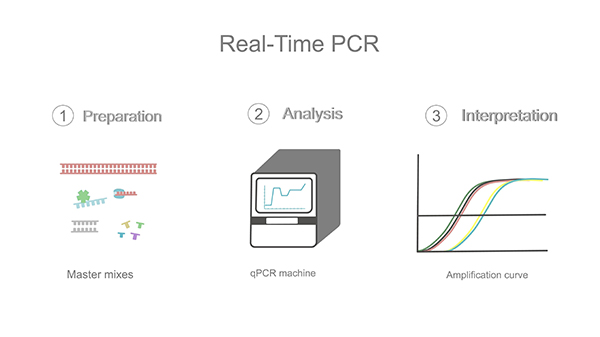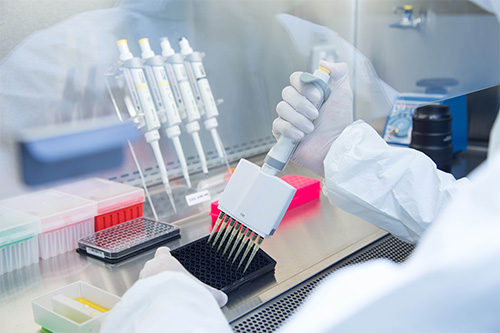Quantitative Real-Time PCR (qPCR)
In the rapid development of life sciences and molecular diagnostics today, real-time fluorescent quantitative PCR (qPCR) has become an indispensable core technology in key fields such as gene expression analysis, pathogen detection, and drug development. As a provider committed to delivering high-quality fluorescent dyes and probes, BOC Sciences has long focused on offering comprehensive solutions for qPCR experiments. This includes standard dyes, custom probes, end-group modifications, and a stringent quality control system to meet the diverse needs of research and industrial clients in areas such as sensitivity, specificity, multiplexing, and quantitative analysis.
What is Quantitative Real-Time PCR?

Real-time fluorescent quantitative PCR (qPCR) is a molecular biology technique that combines fluorescence signal detection with polymerase chain reaction (PCR). This technology enables real-time detection, qualitative, and quantitative analysis of target DNA or RNA by monitoring the fluorescence signal during the amplification process. The principle involves using fluorescently labeled primers or probes, which emit a fluorescent signal as the PCR amplification progresses. As the primers bind to the template DNA, the fluorescence signal gradually increases. By detecting the changes in fluorescence, DNA amplification can be monitored in real time, and quantitative analysis of the target DNA can be performed through methods such as standard curves. qPCR is widely used in molecular diagnostics, genetic analysis, microbial detection, and transcriptome research, and has raised higher requirements for the performance of related fluorescent dyes and probes. Currently, there are two main methods for target detection in qPCR: dye-based detection and probe-based detection.
- Dye-based qPCR: This method utilizes double-stranded DNA binding fluorescent dyes such as SYBR Green and EvaGreen. These dyes intercalate into the double-stranded DNA during synthesis, emitting fluorescence. This method is simple and cost-effective but slightly inferior in specificity analysis.
- Probe-based qPCR: This method typically employs fluorescent probes such as TaqMan, MGB, or Scorpion, which offer high specificity and enable multiplex qPCR analysis. The probes are usually labeled with a fluorescent group at the 5' end and a quencher at the 3' end. Upon binding and amplification, Taq polymerase cleaves the probe, resulting in fluorescence, allowing for high-sensitivity detection.
Advantages of BOC Sciences in qPCR Dye Solutions
Diversified Product Portfolio
We offer a variety of fluorescent dyes (such as FAM, HEX, Cy5, ROX) and paired quenchers (such as BHQ, TAMRA), covering a range of needs from traditional single-channel to multiplex detection.One-Stop Customization Service
From sequence design and end-group modifications to multi-probe optimization, BOC Sciences provides flexible and efficient custom support for research institutions and corporate clients, meeting personalized needs such as specificity, throughput, and channel matching.Comprehensive Quality Control System
All fluorescent dyes and probes undergo multiple quality control methods, including LC-MS, HPLC, and UV, ensuring purity, labeling efficiency, and functional stability, meeting molecular diagnostic standards.Extensive Cross-Industry Application Experience
BOC Sciences' products are widely used in genomics, pathogen detection, environmental monitoring, food safety, and biopharmaceutical industries, offering dye and probe solutions tailored to industry-specific standards.
Fluorescent Dye and Probe Solutions for qPCR
In qPCR research, the quality of fluorescent dyes and probes directly determines the sensitivity, specificity, and reproducibility of experiments. With its deep expertise in organic synthesis and molecular labeling technologies, BOC Sciences has become a key partner for global research and industrial clients in fluorescent labeling solutions. We offer a wide range of high-performance fluorescent dyes and probe products, covering everything from conventional dye molecules (such as SYBR Green, EvaGreen) to highly specific, multi-channel compatible oligonucleotide probes (such as TaqMan probes, molecular beacons). Additionally, we possess significant advantages in fluorophore design, quencher optimization, and probe structure customization, enabling us to provide personalized solutions with high stability, low background, and strong signals tailored to specific experimental needs. Whether for clinical molecular diagnostics, high-throughput screening, or research-grade precise quantitative analysis, BOC Sciences is committed to providing reliable and accurate qPCR fluorescent labeling tools to accelerate your research and application.
Fluorescent Dyes
Fluorescent Probes
- TaqMan probes
- Molecular Beacon probes
- Scorpion probes
- MGB probes (small molecule groove binding)
Fluorophore and Quencher Combinations
- FAM/BHQ1
- HEX/BHQ1
- Cy5/BHQ3
- TAMRA/ROX
Highly Flexible Probe Customization Services from BOC Sciences
To meet the diverse needs of qPCR research, BOC Sciences offers highly flexible probe customization services, combining professional molecular design capabilities with an established chemical synthesis platform to provide clients with quantitative detection tools that offer both high specificity and sensitivity. Whether for scientific exploration or industrial testing, our custom services ensure the precision and stability of experiments.
Experimental Scheme Optimization Suggestions
We provide one-on-one technical support to help clients assess experimental goals and systems, optimize primer/probe concentrations, reaction conditions, and channel configurations, thereby improving qPCR experimental efficiency and data quality.
Probe Sequence Design and Optimization
We design and optimize fluorescent probe sequences based on target genes or sequence specificity, avoiding dimers and non-specific binding to ensure the specificity and accuracy of the amplification reaction.
Extensive End-Group Modification Options
We offer a variety of 5' and 3' end modifications, including common fluorophores and efficient quenchers, to suit different platforms and fluorescent detection channels, adapting to various detection systems.
Multi-Channel Probe Combination Design
We support FAM, HEX, ROX, Cy5, and other multiplex dye combinations to design highly complementary probe systems for multiplex qPCR reactions, enabling high-throughput analysis of multiple targets simultaneously.
Strict Quality Control Ensures the Reliability of Experimental Data
BOC Sciences is committed to providing high-quality fluorescent dyes and probes to our customers. We understand the critical importance of quality control in ensuring the reliability of qPCR experimental data. To this end, we have established a strict quality control system, with comprehensive monitoring and validation at every stage, from raw material procurement, through the production process, to the final product delivery. Our quality control team employs advanced testing equipment and standardized procedures to conduct multiple performance tests on each batch of products, including key indicators such as purity, fluorescence intensity, background noise, and stability, ensuring that each product meets or exceeds international standards. Whether for large-scale production or customized orders, we prioritize quality to ensure that customers obtain consistent, reliable experimental results when using our fluorescent dyes and probes.
- Purity Testing: Every batch of fluorescent dyes and probes undergoes rigorous purity analysis before delivery to ensure no impurities affect experimental results.
- Stability Testing: Through stability tests under conditions like high temperature and long-term storage, we verify the product's stability under various usage conditions.
- Batch Consistency Checks: We ensure that each batch of fluorescent dyes and probes maintains high consistency in performance, providing reliable reproducibility for experiments.
- Fluorescent Labeling Efficiency Determination: We quantify the efficiency of fluorescent labeling through experiments to ensure the signal output strength of the dye or probe is optimal, meeting the requirements of high-sensitivity detection.
- UV Spectral Analysis: Using UV spectral analysis, we accurately verify the absorption peak of the fluorophore, ensuring that the fluorescent dye and probe have optimal excitation and emission characteristics.
- Function Validation: Based on customer requirements, we offer optional PCR verification services to ensure the functionality and reliability of probes under real experimental conditions.
- Detailed Report Documentation: Complete QC reports are provided for all probe products, including UV, HPLC spectra, and mass spectrometry detection reports.
Advanced Analytical Platform
- qPCR Instrument
- Fluorescence Spectrometer
- Multifunctional Microplate Reader
- Laser Scanning Confocal Microscope
- Flow Cytometer
- FL-ELISA Instrument
- Molecular Fluorimeter
- UV-Visible Spectrophotometer
- High-Performance Liquid Chromatograph (HPLC)
- Fluorescence Microscope
- Nuclear Magnetic Resonance Spectrometer (NMR)
- Mass Spectrometer
Research Applications Supported by Fluorescent Dyes and Probes in qPCR
BOC Sciences' fluorescent dyes and probes are widely used in qPCR technology, supporting research and application in multiple fields. Whether in basic research, clinical diagnostics, or industrial testing, our fluorescent labeling tools offer accurate and efficient quantitative analysis to meet diverse experimental needs. Through precise fluorescent probe and dye systems, we provide reliable data support for breakthroughs in gene expression analysis, pathogen detection, drug development, and other research areas.

Molecular Diagnostics
qPCR technology is widely used in molecular diagnostics, especially for gene mutation detection, quantitative analysis of disease biomarkers, and genetic disease screening. With BOC Sciences’ high-sensitivity fluorescent dyes and probes, researchers can accurately detect specific DNA/RNA sequences, quickly diagnose infections, cancers, and other diseases, providing clinicians with precise treatment options.
Drug Development
In the drug development process, qPCR is used to screen the effects of drug candidates on gene expression and evaluate drug efficacy and mechanisms. Our fluorescent dyes and probes enable efficient multiplex detection, helping scientists assess the biological activity of drugs in the early stages and verify their safety and efficacy in preclinical trials.
Genomics Research
qPCR is an essential tool in genomics research, commonly used for the quantitative analysis of gene expression, gene copy number variations, and post-transcriptional modifications. BOC Sciences’ fluorescent labeling products provide high-precision quantitative detection, supporting large-scale data analysis and the exploration of gene regulatory networks in genomics research.
Virus Detection
With the increasing prevalence of infectious diseases, real-time qPCR has become one of the core technologies for virus detection. BOC Sciences’ fluorescent dyes and probes can effectively detect a variety of viruses, such as the COVID-19 virus, influenza virus, and hepatitis B virus, based on high sensitivity and specificity, aiding in rapid responses to public health emergencies.
Food and Environmental Safety Testing
qPCR technology also plays a significant role in food safety and environmental monitoring, enabling the rapid detection of pathogenic microorganisms and contaminants in food. BOC Sciences’ fluorescent dyes and probes provide reliable tools for food and environmental testing, ensuring public health safety and promoting the effective implementation of environmental protection policies.
FAQs About Quantitative Real-Time PCR
What is the real time qPCR method?
Real-time quantitative PCR (qPCR) is a high-sensitivity PCR technique that monitors the fluorescence signal produced during amplification to quantitatively measure the amount of PCR product in real-time. During amplification, the fluorescent dye or probe binds to the PCR product, and as DNA amplifies, the fluorescence signal increases. The device records the changes in fluorescence intensity during each PCR cycle, allowing for precise quantitative gene expression analysis based on the fluorescence signal strength.
What dye is used for qPCR?
Common fluorescent dyes used in qPCR include SYBR Green, EvaGreen, and TaqMan probe dyes. SYBR Green is a commonly used dye that binds to double-stranded DNA and emits fluorescence to detect DNA amplification. EvaGreen is similar to SYBR Green but offers lower background noise and higher signal intensity. TaqMan probes use specific probe sequences that bind to the target DNA and release fluorescence during PCR amplification, typically used in probe-based qPCR assays
What is a probe qPCR?
Probe qPCR is a real-time quantitative PCR method based on fluorescent probes, which use specific probe sequences to detect the amplification of target DNA or RNA. Unlike dye-based methods such as SYBR Green, probe qPCR uses fluorescently labeled probes that bind to the target sequence during PCR amplification, releasing a fluorescence signal. Probe qPCR offers higher specificity and accuracy, making it suitable for gene expression analysis, mutation detection, and other high-precision experiments.
What is the difference between quantitative PCR and RT-qPCR?
Quantitative PCR (qPCR) is a method for real-time monitoring of DNA amplification, which allows the quantification of DNA templates. RT-qPCR (Reverse Transcription qPCR) is a variant of qPCR designed for RNA sample analysis. In RT-qPCR, RNA is first reverse-transcribed into complementary DNA (cDNA) using reverse transcriptase, followed by PCR amplification and quantitative analysis. RT-qPCR is commonly used for gene expression studies to detect changes at the RNA level, while traditional qPCR is primarily used to detect DNA templates.
Online Inquiry

